小学英语学习:to的各种用法归纳
一至四年级英语所有动词
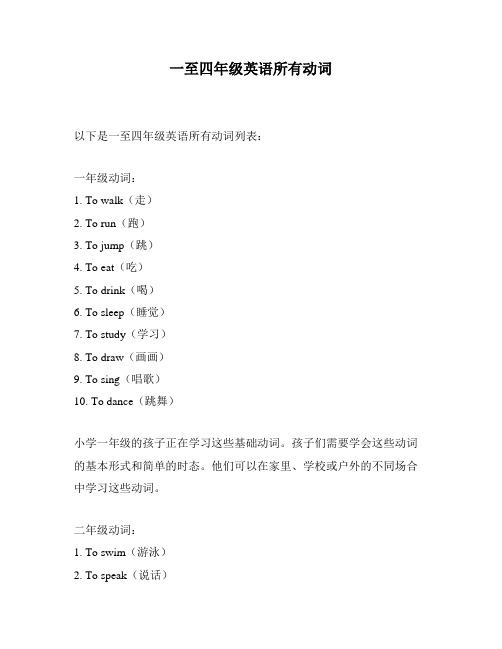
一至四年级英语所有动词以下是一至四年级英语所有动词列表:一年级动词:1. To walk(走)2. To run(跑)3. To jump(跳)4. To eat(吃)5. To drink(喝)6. To sleep(睡觉)7. To study(学习)8. To draw(画画)9. To sing(唱歌)10. To dance(跳舞)小学一年级的孩子正在学习这些基础动词。
孩子们需要学会这些动词的基本形式和简单的时态。
他们可以在家里、学校或户外的不同场合中学习这些动词。
二年级动词:1. To swim(游泳)2. To speak(说话)3. To read(阅读)4. To write(写作)5. To climb(爬山)6. To ride(骑自行车)7. To fly(飞)8. To play(玩耍)9. To watch(观看)10. To listen(听)小学二年级的孩子正逐渐建立起对动词的基本理解。
这些动词与日常生活紧密相关,并提供了更多的机会来学习不同的时态和用法。
三年级动词:1. To speak(说话)2. To listen(听)3. To write(写作)4. To sing(唱歌)5. To dance(跳舞)6. To play(玩耍)7. To study(学习)8. To swim(游泳)9. To run(跑)10. To walk(走)小学三年级的孩子已掌握了基础动词和时态。
这些动词强调了日常活动,并提供了更多的机会来学习不同的用法和意义,以及如何适当地运用这些动词。
四年级动词:1. To ask(问)2. To answer(回答)3. To explain(解释)4. To plant(种植)5. To cook(烹饪)6. To clean(打扫)7. To fix(修理)8. To pick(采摘)9. To help(帮助)10. To play(玩耍)小学四年级的孩子已经学习了许多基础动词和用法,现在需要学习更多复杂的动词和固定短语。
中小学英语语法基础——介词after,before,to,by的用法.doc
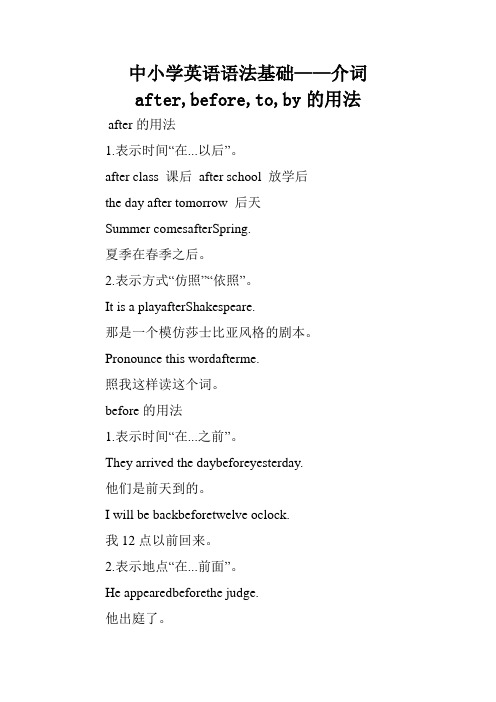
中小学英语语法基础——介词after,before,to,by的用法after的用法1.表示时间“在...以后”。
after class 课后after school 放学后the day after tomorrow 后天Summer comesafterSpring.夏季在春季之后。
2.表示方式“仿照”“依照”。
It is a playafterShakespeare.那是一个模仿莎士比亚风格的剧本。
Pronounce this wordafterme.照我这样读这个词。
before的用法1.表示时间“在...之前”。
They arrived the daybeforeyesterday.他们是前天到的。
I will be backbeforetwelve oclock.我12点以前回来。
2.表示地点“在...前面”。
He appearedbeforethe judge.他出庭了。
to的用法1.表示“向(某处)”“去(某地)”。
All roads leadtoRome.条条大路通罗马。
Could you tell me the waytothe railway station? 你能告诉我去火车站的路吗?2.表示“到...”。
Its tentofour by my watch.我的表是4时差10分。
Dont leave thingstothe last moment.不要把事情都推到最后一刻才做。
by的用法1.表示“在...的旁边”“在...的附近”。
There is a schoolbythe river.在河边有一所学校。
He stoodbyme.他站在我旁边。
We had a daybythe sea.我们在海滨过了一天。
2.表示“最迟在”“在...以前”。
I will be herebyfive oclock.我最迟在5时到这里。
He must have received my letterbynow.他现在一定收到我的信了。
to的用法归纳与总结
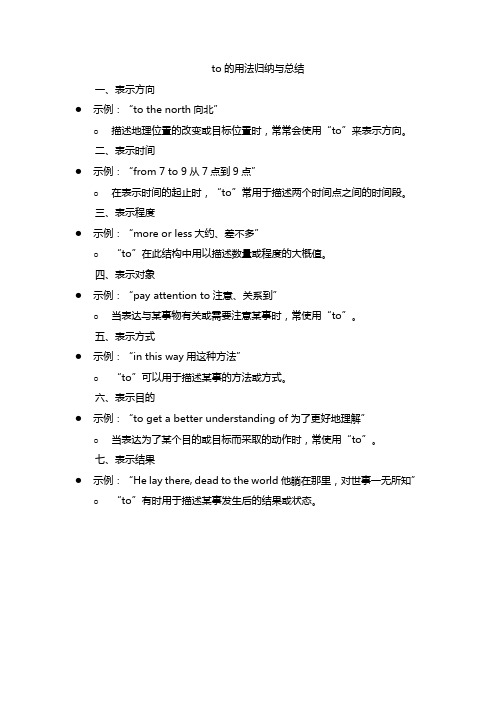
to的用法归纳与总结
一、表示方向
●示例:“to the north向北”
o描述地理位置的改变或目标位置时,常常会使用“to”来表示方向。
二、表示时间
●示例:“from 7 to 9从7点到9点”
o在表示时间的起止时,“to”常用于描述两个时间点之间的时间段。
三、表示程度
●示例:“more or less大约、差不多”
o“to”在此结构中用以描述数量或程度的大概值。
四、表示对象
●示例:“pay attention to注意、关系到”
o当表达与某事物有关或需要注意某事时,常使用“to”。
五、表示方式
●示例:“in this way用这种方法”
o“to”可以用于描述某事的方法或方式。
六、表示目的
●示例:“to get a better understanding of为了更好地理解”
o当表达为了某个目的或目标而采取的动作时,常使用“to”。
七、表示结果
●示例:“He lay there, dead to the world他躺在那里,对世事一无所知”
o“to”有时用于描述某事发生后的结果或状态。
介词to后的用法

介词to后的用法
介词“to”在英语中有多种用法,以下是一些常见的用法:
1. 表示方向:当我们要表示某物朝向某个方向或某个地方时,可以使用介词“to”。
例如,“go to the park”表示去公园的方向。
2. 表示目的地:除了表示方向,介词“to”还可以表示目的地。
例如,“go to school”表示去学校这个目的地。
3. 表示时间:介词“to”也可以表示时间,通常用于表示某个时间点之前或之后。
例如,“10 to 12”表示10点之前或12点之后。
4. 表示对比:介词“to”还可以用于表示对比或比较。
例如,“I am taller than him”可以改写为“I am taller to him”。
5. 表示数量或程度:介词“to”也可以用于表示数量或程度。
例如,“She is 10 years old to him”表示她比他大10岁。
6. 表示目标或期望:介词“to”还可以用于表示目标或期望。
例如,“I want to be a teacher”表示成为一名教师的目标。
7. 表示程度或范围:介词“to”还可以用于表示程度或范围。
例如,“I
li ke apples to an extent”表示我喜欢苹果到一定程度。
需要注意的是,虽然介词“to”有以上多种用法,但在某些情况下,其他介词可能更合适。
因此,在使用介词时,需要根据语境选择最合适的介词。
小学英语动词不定式用法小结及练习

小学英语动词不定式用法小结及练习一、动词不定式的形式动词不定式是动词的一种形式,由“to+动词原形”构成。
例如:to study, to play, to eat等。
二、动词不定式的用法1. 用作动词的宾语:- I want to go to the park.(我想去公园。
)- She likes to play soccer.(她喜欢踢足球。
)2. 用作动词的主语:- To learn English is important.(研究英语很重要。
)- To eat fruits is good for your health.(吃水果对健康有益。
)3. 用作形容词的补语:- I am happy to help you.(我很高兴帮助你。
)- She is eager to learn new things.(她渴望研究新东西。
)4. 用作副词的补语:- He went to the zoo to see the animals.(他去动物园看动物。
)- She ran fast to catch the bus.(她跑得很快以赶上公交车。
)5. 用作名词的补语:6. 用作介词的宾语:- Are you ready to start the game?(你准备好开始比赛了吗?)- She is excited to go on a trip.(她很兴奋去旅行。
)练:1. 请将下列句子中的划线部分改为动词不定式形式:- I like swimming in the pool. → I like to swim in the pool.- They want playing soccer. → They want to play soccer.2. 请填入适当的动词不定式形式:- My dream __________ (be) a teacher.- He needs __________ (study) harder for the exam.3. 请根据句意选择动词不定式的正确形式填空:- She decided ______ (go) to the movie with her friends. 以上是动词不定式的用法小结及相关练。
小学5年级英语动词用法知识点归纳
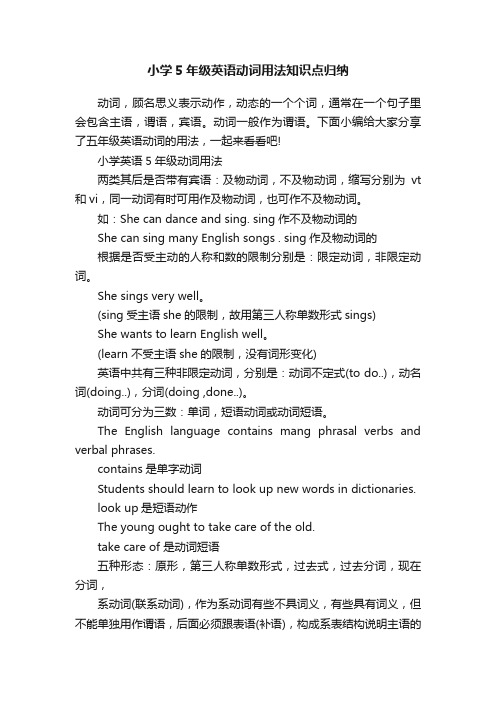
小学5年级英语动词用法知识点归纳动词,顾名思义表示动作,动态的一个个词,通常在一个句子里会包含主语,谓语,宾语。
动词一般作为谓语。
下面小编给大家分享了五年级英语动词的用法,一起来看看吧!小学英语5年级动词用法两类其后是否带有宾语:及物动词,不及物动词,缩写分别为vt 和vi,同一动词有时可用作及物动词,也可作不及物动词。
如:She can dance and sing. sing作不及物动词的She can sing many English songs . sing作及物动词的根据是否受主动的人称和数的限制分别是:限定动词,非限定动词。
She sings very well。
(sing受主语she的限制,故用第三人称单数形式sings)She wants to learn English well。
(learn 不受主语she的限制,没有词形变化)英语中共有三种非限定动词,分别是:动词不定式(to do..),动名词(doing..),分词(doing ,done..)。
动词可分为三数:单词,短语动词或动词短语。
The English language contains mang phrasal verbs and verbal phrases.contains是单字动词Students should learn to look up new words in dictionaries.look up是短语动作The young ought to take care of the old.take care of 是动词短语五种形态:原形,第三人称单数形式,过去式,过去分词,现在分词,系动词(联系动词),作为系动词有些不具词义,有些具有词义,但不能单独用作谓语,后面必须跟表语(补语),构成系表结构说明主语的状况,性质,特征情况状态系动词:表示主语状态,只有be一词:如:He is a teacher . is 与补足语一起说明主语的身份。
to的用法
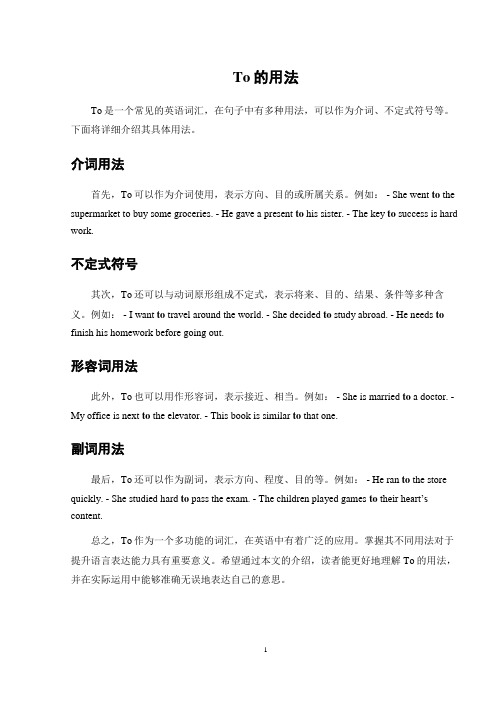
To的用法To是一个常见的英语词汇,在句子中有多种用法,可以作为介词、不定式符号等。
下面将详细介绍其具体用法。
介词用法首先,To可以作为介词使用,表示方向、目的或所属关系。
例如: - She went to the supermarket to buy some groceries. - He gave a present to his sister. - The key to success is hard work.不定式符号其次,To还可以与动词原形组成不定式,表示将来、目的、结果、条件等多种含义。
例如: - I want to travel around the world. - She decided to study abroad. - He needs to finish his homework before going out.形容词用法此外,To也可以用作形容词,表示接近、相当。
例如: - She is married to a doctor. - My office is next to the elevator. - This book is similar to that one.副词用法最后,To还可以作为副词,表示方向、程度、目的等。
例如: - He ran to the store quickly. - She studied hard to pass the exam. - The children played games to their heart’s content.总之,To作为一个多功能的词汇,在英语中有着广泛的应用。
掌握其不同用法对于提升语言表达能力具有重要意义。
希望通过本文的介绍,读者能更好地理解To的用法,并在实际运用中能够准确无误地表达自己的意思。
1。
小学英语语法学习顺口溜(三年级)
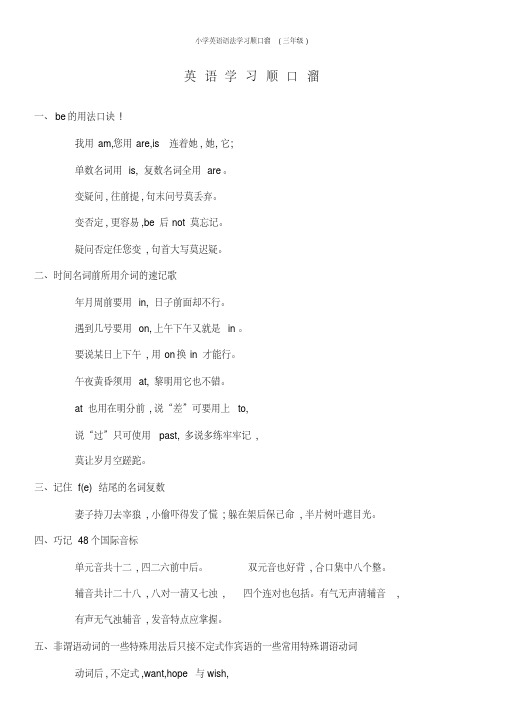
英语学习顺口溜一、be的用法口诀!我用am,您用are,is连着她,她,它;单数名词用is,复数名词全用are。
变疑问,往前提,句末问号莫丢弃。
变否定,更容易,be后not莫忘记。
疑问否定任您变,句首大写莫迟疑。
二、时间名词前所用介词的速记歌年月周前要用in,日子前面却不行。
遇到几号要用on,上午下午又就是in。
要说某日上下午,用on换in才能行。
午夜黄昏须用at,黎明用它也不错。
at也用在明分前,说“差”可要用上to,说“过”只可使用past,多说多练牢牢记,莫让岁月空蹉跎。
三、记住f(e)结尾的名词复数妻子持刀去宰狼,小偷吓得发了慌;躲在架后保己命,半片树叶遮目光。
四、巧记48个国际音标单元音共十二,四二六前中后。
双元音也好背,合口集中八个整。
辅音共计二十八,八对一清又七浊, 四个连对也包括。
有气无声清辅音,有声无气浊辅音,发音特点应掌握。
五、非谓语动词的一些特殊用法后只接不定式作宾语的一些常用特殊谓语动词动词后,不定式,want,hope与wish,agree,decide,mean,manage,promise,expect,pretend,且说两位算在此,要记牢,要记住,掌握它们靠自己。
六、后接动词不定式做宾语补足语省略不定式符号“to”的一些常用特殊动词一些动词要掌握,have,let与make,此三动词就是使役,“注意”“观察”“听到”see,还有feel与watch,使用它们要仔细,后接“宾补”略去“to”,此点千万要牢记除此之外,还可以掌握“八字言”,一感feel,二听hear,listento,三让have,let,make,四瞧see,lookat,observe,watch七、后只接动名词做宾语的一些常用特殊动词特殊动词接“动名”,使用它们要记清,“放弃”“享受”可“后悔”,“坚持”“练习”必“完成”,“延期”“避免”非“介意”掌握它们今必行。
八、动名词在句中的功能及其它“动名”语法其功能,名词特征有动、形,主宾表定都可作,“动名”、“现分”要认清,“现分”不作“宾”与“主”动名作“状”可不行。
小学英语语法用作介词的to
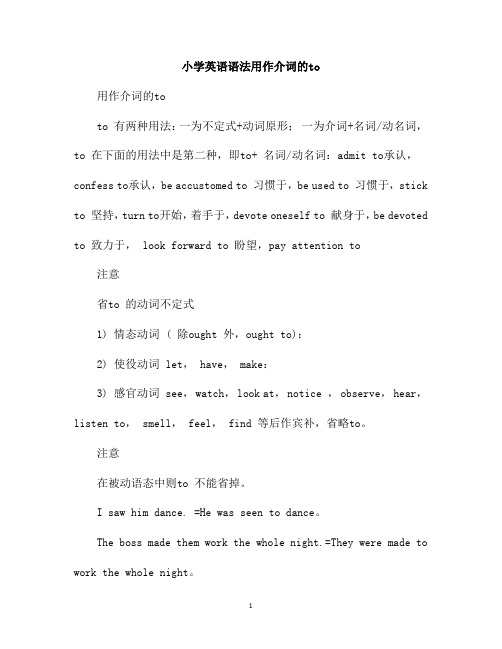
小学英语语法用作介词的to用作介词的toto 有两种用法:一为不定式+动词原形;一为介词+名词/动名词,to 在下面的用法中是第二种,即to+ 名词/动名词:admit to承认,confess to承认,be accustomed to 习惯于,be used to 习惯于,stick to 坚持,turn to开始,着手于,devote oneself to 献身于,be devoted to 致力于, look forward to 盼望,pay attention to注意省to 的动词不定式1) 情态动词 ( 除ought 外,ought to):2) 使役动词 let, have, make:3) 感官动词 see, watch, look at, notice , observe, hear,listen to, smell, feel, find 等后作宾补,省略to。
注意在被动语态中则to 不能省掉。
I saw him dance. =He was seen to dance。
The boss made them work the whole night.=They were made to work the whole night。
4) would rather,had better:5) Why… / why not…:6) help 可带to,也可不带to, help sb (to) do sth:7) but和except:but前是动词do时,后面出现的动词用不带to的动词不定式。
8) 由and, or和than连接的两个不定式,第二个to 可以省去:9) 通常在discover, imagine, suppose, think, understand 等词后,可以省去to be:He is supposed (to be) nice. 他应该是个好人。
举例:He wants to move to France and marry the girl. He wants to do nothing but go out.比较:He wants to do nothing but go out. He wants to believe anything but to take the medicine。
小学英语动词to do、动词ing和动词原形的用法总结及运用技巧

小学英语动词to do、动词ing和动词原形的用法总结及运用技巧动词to do、动词ing和动词原形是小学英语考试的难点,下面介绍它们的用法。
一、动词原形的用法1.在一般现在时中,主语非第三人称单数,其后的动词用原形,例如:We all like learning English.2.祈使句开头的动词用原形,例如:Be quiet!all of you.3.情态动词后面跟动词原形,例如:___ ___.4.固定搭配let sb do sth./make sb do sth./help sb do sth。
例如:Let's have some fun!5.助动词do/does/did以及它们的否定形式后面跟动词原形,例如:Does she read newspapers?6.why not do sth.为什么不做某事,例如:Why not sing a song?二、动词to do的用法1.动词to do形式表目的,放在句首时表达“为了”,放在句中或句末时表达“去干”,例如:To keep safe。
you shouldn't run on the road.2.动词to do也可以用在不定式结构中,例如:What should you do to cross the road safely?3.动词to do也可以用在一些固定搭配中,例如:I want to go to the park to play.以上是动词to do、动词ing和动词原形的用法总结,希望对大家有所帮助。
Beijing is a great n for travelers。
With its rich history and culture。
stunning architecture。
and us food。
it offers a ___ Forbidden City。
climb the Great Wall。
小学英语六年级情态动词用法归纳讲解学习
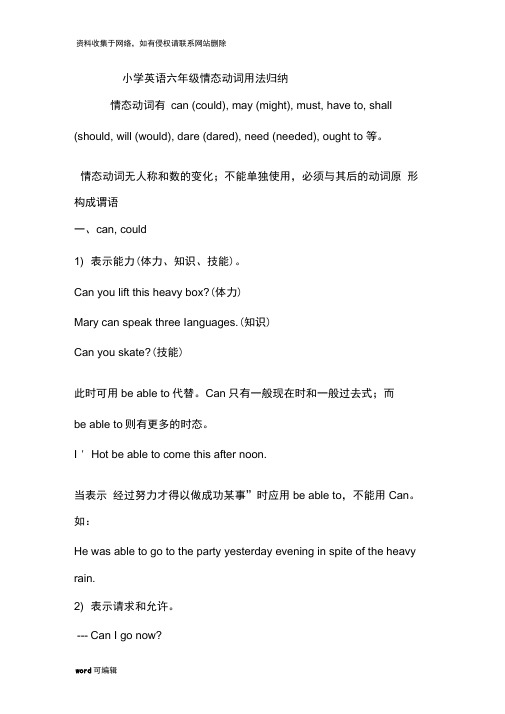
小学英语六年级情态动词用法归纳情态动词有can (could), may (might), must, have to, shall (should, will (would), dare (dared), need (needed), ought to 等。
情态动词无人称和数的变化;不能单独使用,必须与其后的动词原形构成谓语一、can, could1) 表示能力(体力、知识、技能)。
Can you lift this heavy box?(体力)Mary can speak three Ianguages.(知识)Can you skate?(技能)此时可用be able to代替。
Can只有一般现在时和一般过去式;而be able to则有更多的时态。
I ' Hot be able to come this after noon.当表示经过努力才得以做成功某事”时应用be able to,不能用Can。
如:He was able to go to the party yesterday evening in spite of the heavy rain.2) 表示请求和允许。
--- Can I go now?——Yes, you can. / No, you can' t.此时可与may互换。
在疑问句中还可用could,might代替,不是过去式,只是语气更委婉,不能用于肯定句和答语中。
——Could I come to see you tomorrow?----Yes, you can. ( No, I ' mfraid not.)3)表示客观可能性(客观原因形成的能力)。
They' vecha nged the timetable, so we can go by bus in stead.This hall can hold 500 people at least.4)表示推测(惊讶、怀疑、不相信的态度),用于疑问句、否定句和感叹句中。
小学英语学习:to的各种用法归纳

【导语】to是⼀个英⽂单词,可以⽤作连接词,介词等词性,英式读⾳“tə”、美式读⾳“tu、tə”,意思是向、往、给、于等。
to 的⽤法有很多种,⽆忧考整理了相关内容,快来看看吧!希望能帮助到你~更多相关讯息请关注⽆忧考! ⼀:表⽰相对,针对 be strange (common, new, familiar, peculiar, distinct, sensitive, immune, vulnerable, indispensable)to Air is indispensable to life. Aircrafts are vulnerable to interference caused by radiation. This injection will make you immune to infection. ⼆:表⽰对⽐,⽐较 1:以-ior结尾的形容词,后接介词to表⽰⽐较,如:superior ,inferior,prior,senior,junior The quarrel happened prior to my arrival. 2: ⼀些本⾝就含有⽐较或⽐拟意思的形容词,如equal,similar,equivalent,analogousA is similar toB in many ways. 3:表⽰⼀些先后顺序的形容词,如:second,subsequent,next,preliminary,preparatory Subsequent to the war,they returned to their hometown. 4: to也偶尔出现在个别动词之后,与动词形成固定词组,表⽰⽐较,如:prefer to,compare to,in contrast to compare to sth.表⽰⽐喻或⽐拟,⽽compare with sth.表⽰⽐较,如: World is usually compared to a stage Compared with his past,he has changed a lot. Prefer的正确句型是:prefer A to B或prefer doing A to doing B,但当prefer后接动词不定式时,表⽰⽐较的介 词to就要改成rather than ,如: The undaunted soldier preferred death to surrender. Many people prefer spending money to earning money. They prefer to pursue careers rather than remain home as house wives. 5: to与及个别的名词构成⽐较之意,如:alternative Going to an under water concert is a great alternative to going to dinner. 三: 表⽰修饰关系 1: 表⽰回复,反应意思的词,如:answer to question, solution to problem,response to inquiry,reaction to proposal,reply to letter 2: 表⽰建筑构件的词汇,如: entry,entrance,approach,access,passage,exit,vent,path the approach to a bridge引桥 the approach to science Half of the population was estimated to have no access to the health service. The access to education 接受教育的机会 The access to medical care 享受公费医疗的权利 3: 表⽰⼈物职位和官衔的词,如:assistant to manager, ambassador to Spain, successor to tradition, heir to throne,deputy to the National People's Congress advisor to the Prime Minister 4: 表⽰权利和许可的词汇,如:right,admission The employee finally got the admission to the boardroom. Everyone has an equal right to ………… 5: 表⽰栅栏或障碍的词汇,如:bars to development,the barrier to progress 6: 表⽰与书籍,⽂本相关的词,如:introduction to passage. 7: 表⽰恭喜或是祝贺,如: The director proposed a toast to the health of the guests. Let's drink to Dick's success in business 8: 另外还有⼀些名词符合这种⽤法,有的具有两者息息相关,缺⼀不可的含义.如:key to door,invitation to party, guide to action,limitation to life,accessory to school 四: to还具有依据,伴随,和着节奏的含义,如:sing to piano, chance to the tune, stamp to the rhythm of the song, add salt to taste (⼀):表⽰相关联,相连接,如:be related to,be relative to,in relation to,be relevant t Investigate all the facts related to the problem. People often linked walth to happiness. (⼆):表⽰反对和赞同。
小学五年级英语动词用法:to do.doc
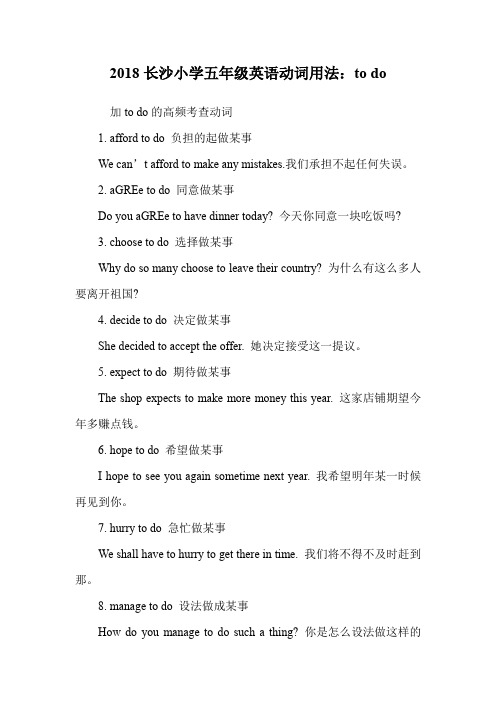
2018长沙小学五年级英语动词用法:to do加to do的高频考查动词1. afford to do 负担的起做某事We can’t afford to make any mistakes.我们承担不起任何失误。
2. aGREe to do 同意做某事Do you aGREe to have dinner today? 今天你同意一块吃饭吗?3. choose to do 选择做某事Why do so many choose to leave their country? 为什么有这么多人要离开祖国?4. decide to do 决定做某事She decided to accept the offer. 她决定接受这一提议。
5. expect to do 期待做某事The shop expects to make more money this year. 这家店铺期望今年多赚点钱。
6. hope to do 希望做某事I hope to see you again sometime next year. 我希望明年某一时候再见到你。
7. hurry to do 急忙做某事We shall have to hurry to get there in time. 我们将不得不及时赶到那。
8. manage to do 设法做成某事How do you manage to do such a thing? 你是怎么设法做这样的事?9. plan to do 打算做某事Where do you plan to spend your holiday? 你打算去哪里度假?10. prefer to do 宁愿做某事I prefer to travel in the front of the car. 我宁愿坐在汽车的前面。
11. refuse to do 拒绝做某事I refuse to answer that question. 我不愿回答那个问题。
动词不定式归纳用法
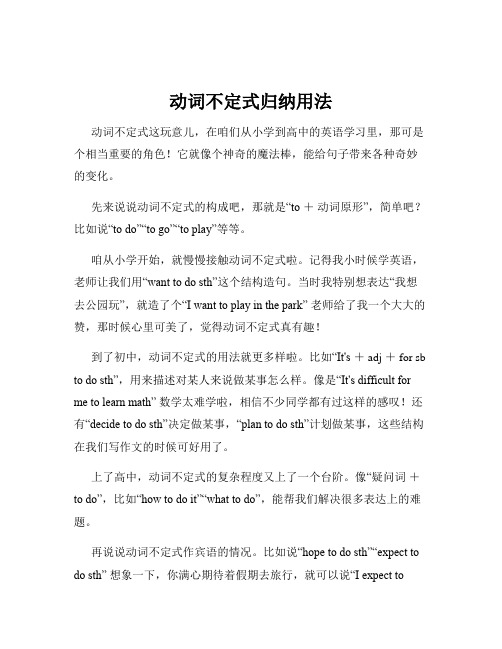
动词不定式归纳用法动词不定式这玩意儿,在咱们从小学到高中的英语学习里,那可是个相当重要的角色!它就像个神奇的魔法棒,能给句子带来各种奇妙的变化。
先来说说动词不定式的构成吧,那就是“to +动词原形”,简单吧?比如说“to do”“to go”“to play”等等。
咱从小学开始,就慢慢接触动词不定式啦。
记得我小时候学英语,老师让我们用“want to do sth”这个结构造句。
当时我特别想表达“我想去公园玩”,就造了个“I want to play in the park” 老师给了我一个大大的赞,那时候心里可美了,觉得动词不定式真有趣!到了初中,动词不定式的用法就更多样啦。
比如“It's + adj + for sb to do sth”,用来描述对某人来说做某事怎么样。
像是“It's difficult for me to learn math” 数学太难学啦,相信不少同学都有过这样的感叹!还有“decide to do sth”决定做某事,“plan to do sth”计划做某事,这些结构在我们写作文的时候可好用了。
上了高中,动词不定式的复杂程度又上了一个台阶。
像“疑问词+to do”,比如“how to do it”“what to do”,能帮我们解决很多表达上的难题。
再说说动词不定式作宾语的情况。
比如说“hope to do sth”“expect to do sth” 想象一下,你满心期待着假期去旅行,就可以说“I expect totravel during the vacation” 那种期待的心情一下子就通过这个句子表达出来了。
还有作宾语补足语的时候,“ask sb to do sth”让某人做某事。
我记得有一次,我妈让我帮忙做家务,她说“Co uld you please help me to do some housework?” 我虽然有点不情愿,但还是乖乖去做啦。
小学英语语法介词to和of与for的用法及练习含答案

小学英语语法介词to,of与for的用法To、of与for是三个极易混用的介词,在具体使用时应从以下三个方面来掌握:一、表示“……的”含义时,应根据不同的关系选用不同的介词。
1.若表示“所有,所属”关系时,用介词of。
如: the life ofthe people 人民的生活the roofof the house 屋顶2.若表示“解释,说明”关系时,用介词for。
如: the money for the shoes 鞋钱the shop for clothes 成衣店3.若表示“解答,用途”关系时,用介词to。
如:the key to the exercise 练习的答案the way to the hospital(到)医院的路二、在含有双宾语的句子中,当间接宾语(指人的宾语)置于直接宾语(指物的宾语)之后时,间接宾语之前须加上介词to或for。
1.当及物动词是give,pass,tell,teach,ask,show 等必须有双宾语意义才完整的句子中,若将间接宾语放在直接宾语之后,用介词to 连接。
如:Miss Cao teaches English to us. 曹老师教我们英语。
Please pass a cup oftea to me.请给我一杯茶。
2.当及物动词是make,buy,fetch,get,play,find 等只需一个宾语就能表达一个完整意义的句子中,若将间接宾语放在直接宾语后面时,用介词for 连接。
如:Her uncle bought a new bike for her.她叔叔给她买了一辆新自行车。
Mother cooks breakfast for us every day.妈妈每天为我们做早饭三、当不定式短语作主语,谓语是系表结构(即“It+be+形容词+不定式”句型)时,若不定式动词需要逻辑主语时,其引导词可以是of也可以是for。
二者的选择主要取决于该句型中的形容词。
外研社小学英语一年级知识点【上下册】
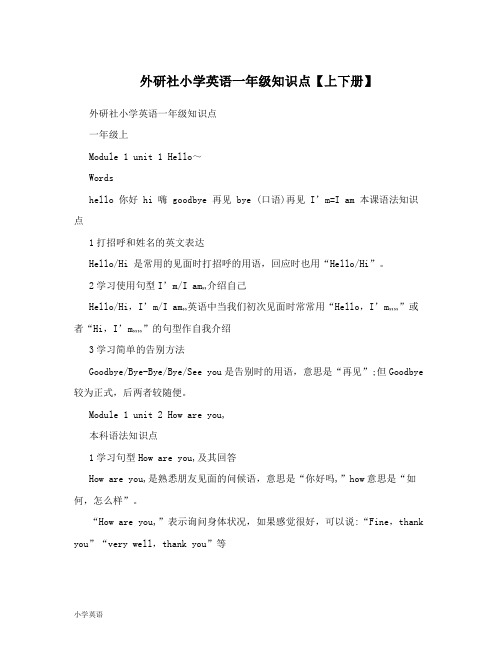
外研社小学英语一年级知识点【上下册】外研社小学英语一年级知识点一年级上Module 1 unit 1 Hello~Wordshello 你好 hi 嗨 goodbye 再见 bye (口语)再见I’m=I am 本课语法知识点1打招呼和姓名的英文表达Hello/Hi 是常用的见面时打招呼的用语,回应时也用“Hello/Hi”。
2学习使用句型I’m/I am…介绍自己Hello/Hi,I’m/I am…英语中当我们初次见面时常常用“Hello,I’m……”或者“Hi,I’m……”的句型作自我介绍3学习简单的告别方法Goodbye/Bye-Bye/Bye/See you是告别时的用语,意思是“再见”;但Goodbye 较为正式,后两者较随便。
Module 1 unit 2 How are you,本科语法知识点1学习句型How are you,及其回答How are you,是熟悉朋友见面的问候语,意思是“你好吗,”how意思是“如何,怎么样”。
“How are you,”表示询问身体状况,如果感觉很好,可以说:“Fine,thank you”“ver y well,thank you”等当别人问“How are you,”时,你可以回答:“I’m fine,thanks,and you,”“And you,”意思是“你怎么样呢,”,对方如何身体很好,可以回答:I’m fine,too.(我也很好。
) Module 2 unit 1 What’s your name,Wordsgood 好的 morning 早晨,上午what’s=what is 是什么 my 我的 name 名字本课语法知识点1学习如何自我介绍和如何询问他人姓名Good morning是早上见面打招呼所用的句子,意思是“早上好”,good是“好”的意思;别人向你说Good morning时,你也要用Good morning来回答。
to的用法口诀小学

to的用法口诀小学今天我们来讨论一个英语中常见的小词——to。
虽然它只有两个字母,但在句子中却有着多种不同的用法,让很多小学生感到困惑。
让我们一起来学习一下to的用法口诀吧!首先,to可以表示方向或目的。
比如:I am going to school.(我要去学校。
)这里的to表明了动作的方向。
再比如:She is studying hard to pass the exam.(她努力学习以通过考试。
)在这句话中,to表达了动作的目的。
其次,to还可以和动词原形构成不定式。
不定式是动词的一种形式,一般不受主语的人称或数的变化。
比如:I want to dance.(我想要跳舞。
)这里的to dance中的dance就是动词的原形。
另外,to还可以用在某些固定短语中,例如: - go to bed(上床睡觉) - listen to music(听音乐) - talk to friends(和朋友交谈) - look forward to(期待)此外,to还可以用在不定量词前,表示一个概括的范围,比如: - all of the students (所有的学生) - some of the books(一些书籍) - most of the time(大部分时间) - a lot of money(许多钱)最后,to有时候也可以用来连接两个名词,表示所属关系。
比如:the door to the room(通往房间的门),my love to you(我对你的爱)。
总结一下,to在英语中有很多种用法,包括表示方向或目的、构成不定式、用在固定短语中、连接不定量词以及表示所属关系等。
希望通过这个口诀,大家能更好地掌握to 的用法,写出更加准确的句子。
让我们一起努力,提高英语能力!1。
小学四年级英语学习指导:介词的用法(表地点)
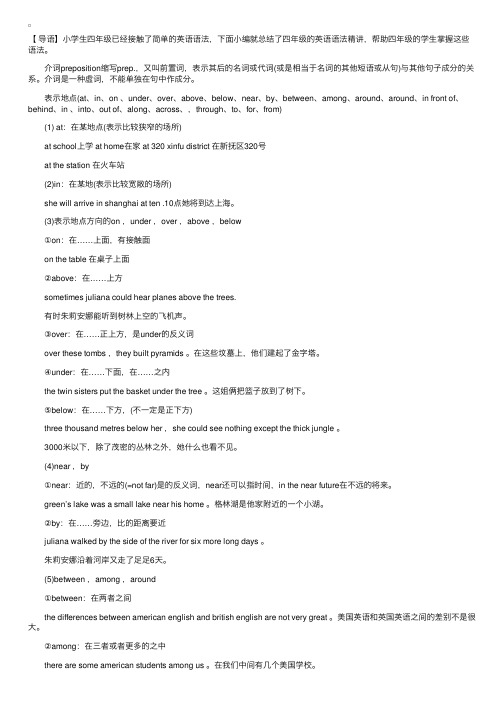
【导语】⼩学⽣四年级已经接触了简单的英语语法,下⾯⼩编就总结了四年级的英语语法精讲,帮助四年级的学⽣掌握这些语法。
介词preposition缩写prep.,⼜叫前置词,表⽰其后的名词或代词(或是相当于名词的其他短语或从句)与其他句⼦成分的关系。
介词是⼀种虚词,不能单独在句中作成分。
表⽰地点(at、in、on 、under、over、above、below、near、by、between、among、around、around、in front of、behind、in 、into、out of、along、across、,through、to、for、from) (1) at:在某地点(表⽰⽐较狭窄的场所) at school上学 at home在家 at 320 xinfu district 在新抚区320号 at the station 在⽕车站 (2)in:在某地(表⽰⽐较宽敞的场所) she will arrive in shanghai at ten .10点她将到达上海。
(3)表⽰地点⽅向的on ,under ,over ,above ,below ①on:在……上⾯,有接触⾯ on the table 在桌⼦上⾯ ②above:在……上⽅ sometimes juliana could hear planes above the trees. 有时朱莉安娜能听到树林上空的飞机声。
③over:在……正上⽅,是under的反义词 over these tombs ,they built pyramids 。
在这些坟墓上,他们建起了⾦字塔。
④under:在……下⾯,在……之内 the twin sisters put the basket under the tree 。
这姐俩把篮⼦放到了树下。
⑤below:在……下⽅,(不⼀定是正下⽅) three thousand metres below her ,she could see nothing except the thick jungle 。
小学英语语法
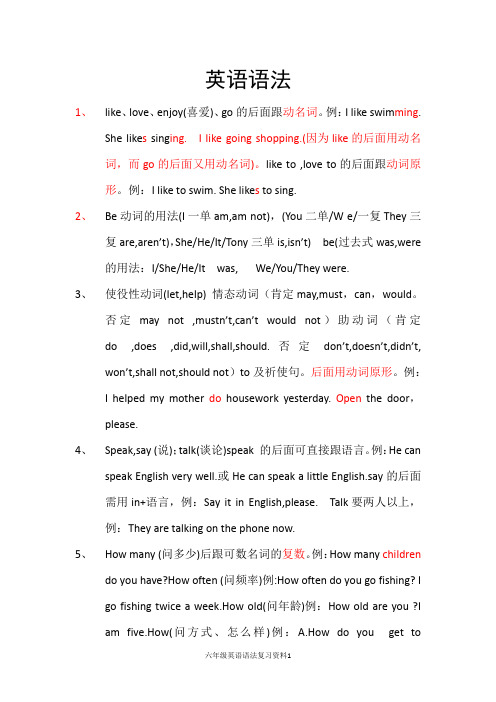
英语语法1、like、love、enjoy(喜爱)、go的后面跟动名词。
例:I like swim ming.She like s sing ing. I like going shopping.(因为like的后面用动名词,而go的后面又用动名词)。
like to ,love to的后面跟动词原形。
例:I like to swim. She like s to sing.2、Be动词的用法(I一单am,am not),(You二单/W e/一复They三复are,aren’t),She/He/It/Tony三单is,isn’t) be(过去式was,were的用法:I/She/He/It was, We/You/They were.3、使役性动词(let,help) 情态动词(肯定may,must,can,would。
否定may not ,mustn’t,can’t would not)助动词(肯定do ,does ,did,will,shall,should.否定don’t,doesn’t,didn’t, won’t,shall not,should not)to及祈使句。
后面用动词原形。
例:I helped my mother do housework yesterday. Open the door,please.4、Speak,say (说);talk(谈论)speak 的后面可直接跟语言。
例:He canspeak English very well.或He can speak a little English.say的后面需用in+语言,例:Say it in English,please. Talk要两人以上,例:They are talking on the phone now.5、How many (问多少)后跟可数名词的复数。
例:How many childrendo you have?How often (问频率)例:How often do you go fishing? I go fishing twice a week.How old(问年龄)例:How old are you ?I am five.How(问方式、怎么样)例:A.How do you get toGuangzhou?I am going to get there by bus. B.How is your father? He is fine. How much (问价格)How much is a pair of socks?It’s four yuan.如果量词pair是单数,be动词就用单数is,如果量数pair是复数,be就用复数。
- 1、下载文档前请自行甄别文档内容的完整性,平台不提供额外的编辑、内容补充、找答案等附加服务。
- 2、"仅部分预览"的文档,不可在线预览部分如存在完整性等问题,可反馈申请退款(可完整预览的文档不适用该条件!)。
- 3、如文档侵犯您的权益,请联系客服反馈,我们会尽快为您处理(人工客服工作时间:9:00-18:30)。
小学英语学习:to的各种用法归纳
一:表示相对,针对
be strange (common, new, familiar, peculiar, distinct, sensitive, immune, vulnerable, indispensable)to
Air is indispensable to life.
Aircrafts are vulnerable to interference caused by radiation.
This injection will make you immune to infection.
二:表示对比,比较
1:以-ior结尾的形容词,后接介词to表示比较,如:superior ,inferior,prior,senior,junior
The quarrel happened prior to my arrival.
2:一些本身就含有比较或比拟意思的形容词,如equal,similar,equivalent,analogous
A is similar to
B in many ways.
3:表示一些先后顺序的形容词,如:
second,subsequent,next,preliminary,preparatory
Subsequent to the war,they returned to their hometown.
4: to也偶尔出现在个别动词之后,与动词形成固定词组,表示比较,如:prefer to,compare to,in contrast to
compare to sth.表示比喻或比拟,而compare with sth.表示比较,如:
World is usually compared to a stage
Compared with his past,he has changed a lot.
Prefer的准确句型是:prefer A to B或prefer doing A to doing B,但当prefer后接动词不定式时,表示比较的介
词to就要改成rather than ,如:
The undaunted soldier preferred death to surrender.
Many people prefer spending money to earning money.
They prefer to pursue careers rather than remain home as house wives.
5: to与及个别的名词构成比较之意,如:alternative
Going to an under water concert is a great alternative to going to dinner.
三:表示修饰关系
1:表示回复,反应意思的词,如:answer to question,
solution to problem,response to inquiry,reaction to proposal,reply to letter
2:表示建筑构件的词汇,如:
entry,entrance,approach,access,passage,exit,vent,path
the approach to a bridge引桥
the approach to science
Half of the population was estimated to have no access to the health service.
The access to education 接受教育的机会
The access to medical care 享受公费医疗的权利
3:表示人物职位和官衔的词,如:assistant to manager, ambassador to Spain, successor to tradition, heir to
throne,deputy to the National People's Congress
advisor to the Prime Minister
4:表示权利和许可的词汇,如:right,admission
The employee finally got the admission to the boardroom.
Everyone has an equal right to …………
5:表示栅栏或障碍的词汇,如:bars to development,the barrier to progress
6:表示与书籍,文本相关的词,如:introduction to passage.
7:表示恭喜或是祝贺,如:
The director proposed a toast to the health of the guests.
Let's drink to Dick's success in business
8:另外还有一些名词符合这种用法,有的具有两者息息相关,缺一不可的含义.如:key to door,invitation to party, guide to action,limitation to life,accessory to school
四: to还具有依据,伴随,和着节奏的含义,如:sing to piano, chance to the tune, stamp to the rhythm of the song, add salt to taste
(一):表示相关联,相连接,如:be related to,be
relative to,in relation to,be relevant t Investigate all the facts related to the problem.。
